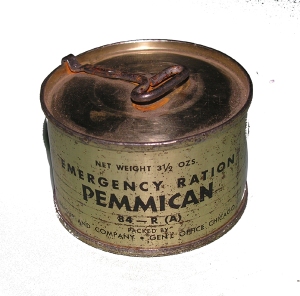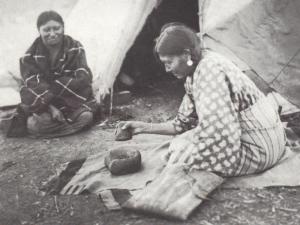Tags
I love the idea of any food that is billed as coming from the wilds of North America. Pemmican was just such a survival food. “The word is from Cree pĭmĭkân, manufactured grease”, or one who makes grease. “The word is cognate with Abnaki pĕmĭkân. It was made from whatever meat was the most abundant in a particular region. In the northernmost areas reindeer was used, in milder climates buffalo was usually specified as being prevalent although deer and other animals were used.
The process was pretty much the same regardless of the type of meat used. After removing fat and gristle the meat was sliced, hung to dry, perhaps smoked as it dried, and then pounded to a powder. The meat powder was mixed with fat, many accounts specify the fat came from marrow in the bones of the animal, and dried fruit was sometimes incorporated. Once well mixed the mass was packed into skin bags and the bags sewn shut. It kept several years as long as it was stored away from excess moisture. Natives also stored it away in woven baskets.
An account published in 1860 stated that the pemmican was packed tightly into tin canisters leaving a little space at the top, and allowed to cool after which the tin was filled to the brim with hot melted lard. A lid was then soldered onto the canister sealing in the pemmican. – The Household Monthly. March 1860.
Any berries that were available were probably added to sweeten the pemmican, but a few of the fruits I was able to document as an ingredient included June Berry (also called pemmican berry because it was frequently used in that manner), choke cherry, Saskatoon, Service berries, cranberries, Manzanita, blueberries, Juniper berries, currants, etc.
“Sweet pemmican is a superior kind of pemmican in which the fat used is obtained from marrow by boiling broken bones in water. Fish pemmican is a pemmican made by the Indians of the remote regions of the N. W. by pounding dried fish and mixing the product with sturgeon oil. The Eskimo of Alaska make a pemmican by mixing chewed deer meat with deer suet and seal-oil.”
Pemmican was made into soup by hunters, trappers, arctic explorers, etc. called Robbiboe, or by the Canadian French rababou. To make it the pemmican was mixed with a little flour and water and boiled.
Sir Alexander Mackenzie can be consulted for an idea of the weight of the packs of pemmican. For a journey from Montreal south on the St. Lawrence River he noted the party carried four bags and a half of pemmican, weighing from eighty-five to ninety pounds each in addition to other supplies. – Mackenzie, Alexander, Sir. Voyages from Montreal, on the River St. Laurence Through the Continent of North America, to the Frozen and Pacific Oceans in the Years 1789 and 1793. 1814. New York.
Robert Huish wrote of a party that carried along an amazing sixty bags each weighing ninety pounds. Gould tells us that, “one bison cow in good condition furnished dried meat and fat enough to make a bag of pemmican weighing ninety pounds”. Given that, it becomes clear how much less the meat weighed after processing having removed the bones, skin, etc. and through evaporation in the drying process.
– A Narrative of the Voyages and Travels of Captain Beechey: To the Pacific and Behring’s Straits and The Travels of Capt. Back, R. N. to the Great Fish River and Arctic Seas. 1836. London. Gould, Augustus Addison. The Naturalist’s Library: Containing Scientific and Popular Descriptions of Natural History. 1833. Massachusetts.
Hamilton reckoned one pound of pemmican was equal to five pounds of meat. – Hamilton, William. My Sixty Years on the Plains. 1905. NY.
The following recipe came from Frances Owens’s book, Mrs. Owens’ Cook Book, 1903. “Pemmican is made of the lean portions of venison, buffalo, etc. The Indian method is to remove the fat from the lean, dry the lean in the sun; then make a bag of the skin of the animal, and put the lean pieces in loosely. To this must be added the fat of the animal, rendered into tallow, and poured in quite hot. This will cause the spaces to be filled. When cold, put away for future use. In civilized life, a jar can be used in place of the bag. Pemmican may be cooked same as sausage, or eaten as dried beef. It is invaluable in long land explorations, and is of great use in sea voyages.”
For those who prefer more of an actual recipe than a method summary, Mrs. Saray Tyson Rorer offered one, although it varied in method. ¼ pound of lean beef put twice through a meat chopper, ¼ pound of marrow from the leg or shin bone of an ox.
Chop the marrow with a silver knife and remove the fibre. Mix the beef and marrow thoroughly, a half saltspoonful of salt and stand at once in a cold place. – Mrs. Rorer’s Diet for the Sick. 1914.
Blissful meals, yall. – thehistoricfoodie.wordpress.com©
See: Hodge, Frederick Webb. Handbook of American Indians North of Mexico. Washington Government Printing Office. 1912.



Fascinating read. Thank you!
This was such an interesting article, I’ve never heard of Pemmican before! Sounds a but like our gold old Spam. Regards from London. Julia
Julia: Glad you enjoyed the article. I visited London a few years ago and enjoyed it immensely. V.